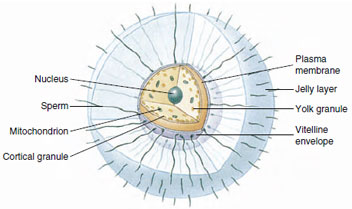Contact and Recognition between Egg and Sperm
Contact and Recognition
between Egg and Sperm
Most marine invertebrates and many
marine fishes simply release their
gametes into the ocean. Although an
egg is a large target for a sperm, the
enormous dispersing effect of the
ocean and limited swimming range of
a spermatozoon conspire against an
egg and a sperm coming together by
chance encounter. To improve likelihood
of contact, eggs of numerous
marine species release a chemotactic
factor that attracts sperm to the egg.
The chemotactic molecule is speciesspecific,
attracting to the egg only
sperm of the same species.
In sea urchin eggs, sperm first penetrate a jelly layer surrounding the egg, then contact the egg’s vitelline envelope, a thin membrane lying just above the egg plasma membrane (Figure 8-3). At this point, egg-recognition proteins on the acrosomal process of the sperm (Figure 8-4) bind to speciesspecific sperm receptors on the vitelline envelope. This mechanism ensures that the egg will recognize only sperm of the same species; all others are screened out. This is important in the marine environment where many closely related species may be spawning at the same time. Similar recognition proteins have been found on the sperm of vertebrate species (including mammals) and presumably are a universal property of animals.
 |
| Figure 8-3 Structure of sea urchin egg at the moment of fertilization. |
In sea urchin eggs, sperm first penetrate a jelly layer surrounding the egg, then contact the egg’s vitelline envelope, a thin membrane lying just above the egg plasma membrane (Figure 8-3). At this point, egg-recognition proteins on the acrosomal process of the sperm (Figure 8-4) bind to speciesspecific sperm receptors on the vitelline envelope. This mechanism ensures that the egg will recognize only sperm of the same species; all others are screened out. This is important in the marine environment where many closely related species may be spawning at the same time. Similar recognition proteins have been found on the sperm of vertebrate species (including mammals) and presumably are a universal property of animals.
 |
| Figure 8-4 Sequence of events during sperm contact and penetration of a sea urchin egg. |




